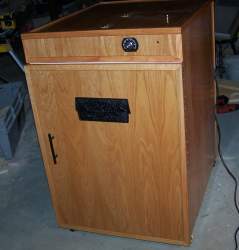There is likely a good reason all current incubators are made with top heating even if some older ones can function with bottom heat. I would think anything with a constant heat source, which was more common in the first incubator designs, would work to have it on the bottom. You have the same amount of heat always going up from the bottom and would just regulate that amount to change the temp instead of the time it was on. However in one that has a thermostat turning on and shutting off the heat to control temperature instead of changing the amount of heat produced I think you will run into temperature layering problems. When the thermostat goes off the heat sits at the top and the bottom cools. If we are forcing the heat down from the source it is always trying to go back up so we get lots of air movement. If the heat is coming from the bottom it already wants to go away from the heat element. You would have to run a lot more fans to move it around because just pointing one away from the heat source will only increase what it wants to do potentially making layering worse instead of better. Increasing air movement increases moisture lost from the eggs and drying of membranes during hatching. You will have to be more exact with the humidity and it may not work at all.


 [/img]
[/img]
 [/img]
[/img]
 [/img]
[/img]
 [/img]
[/img]





